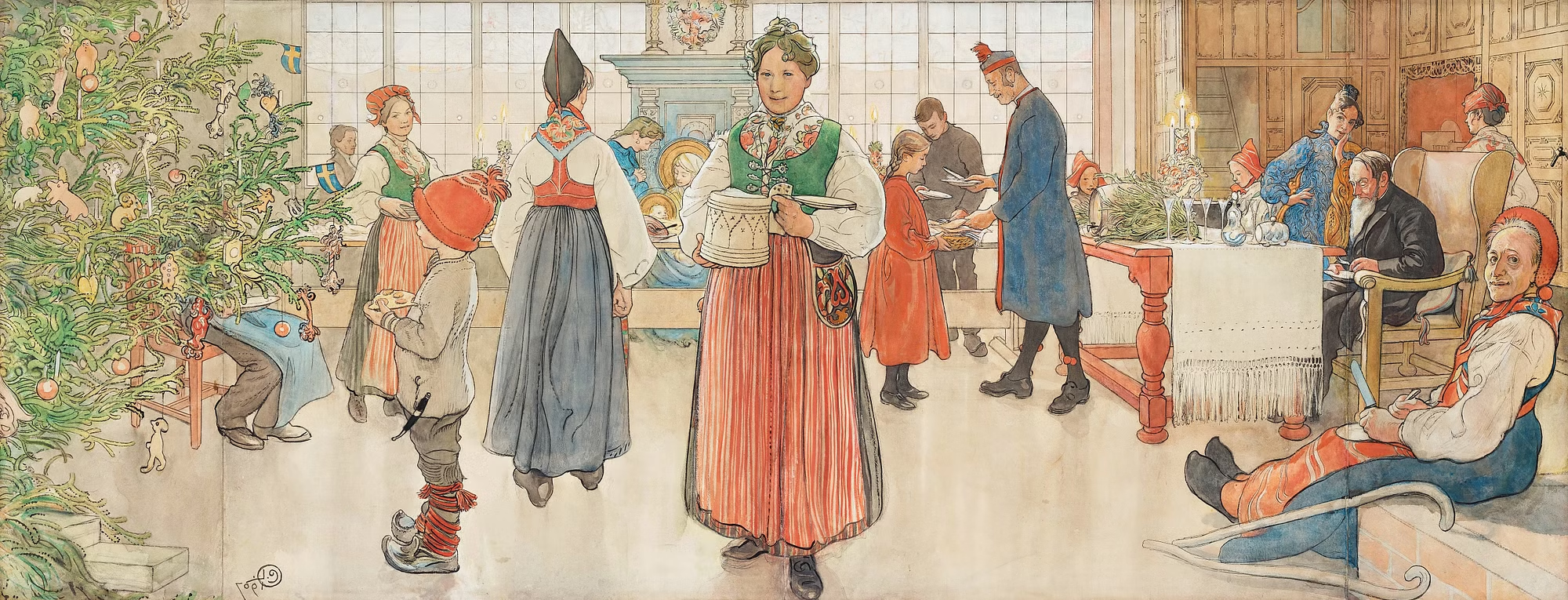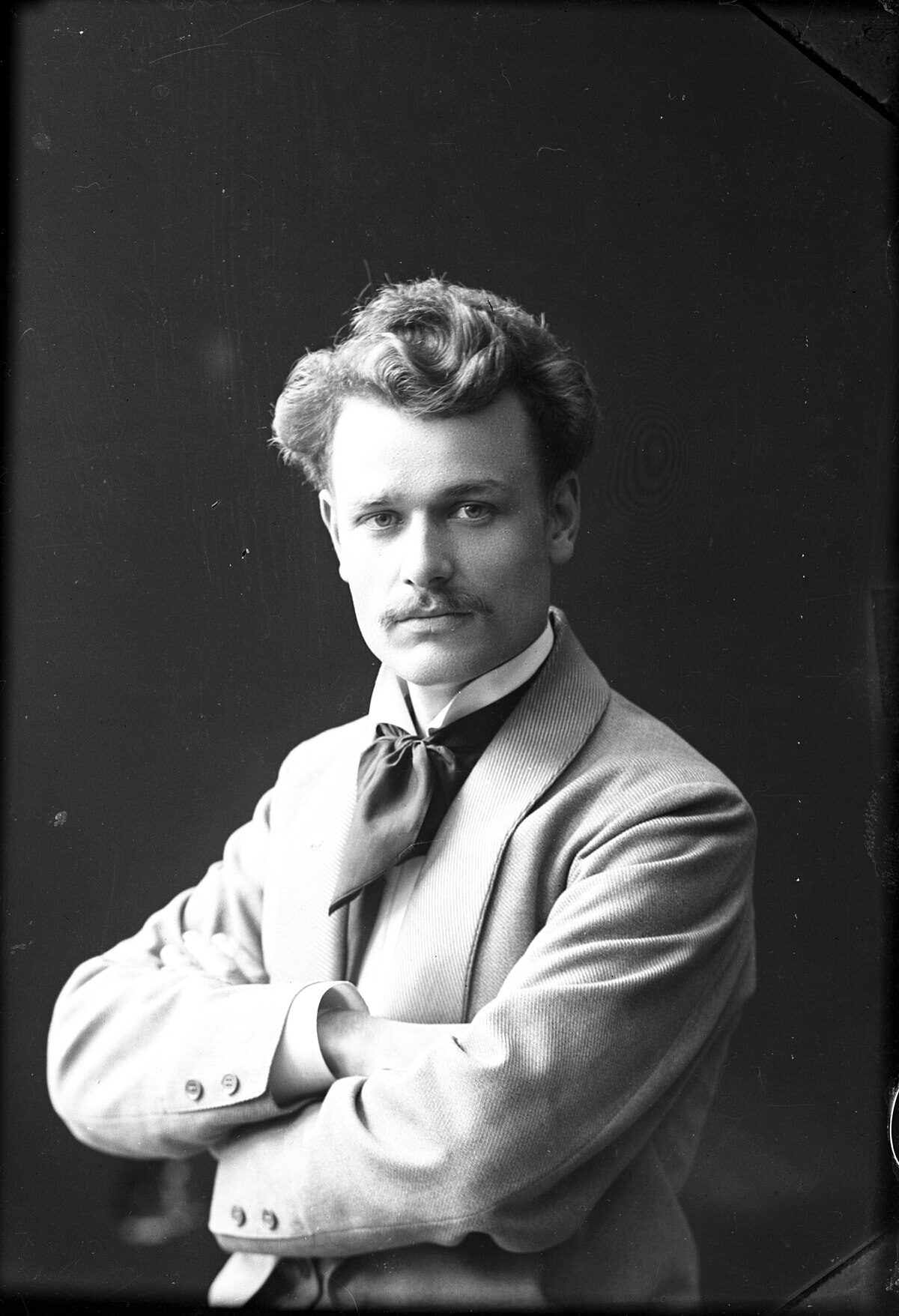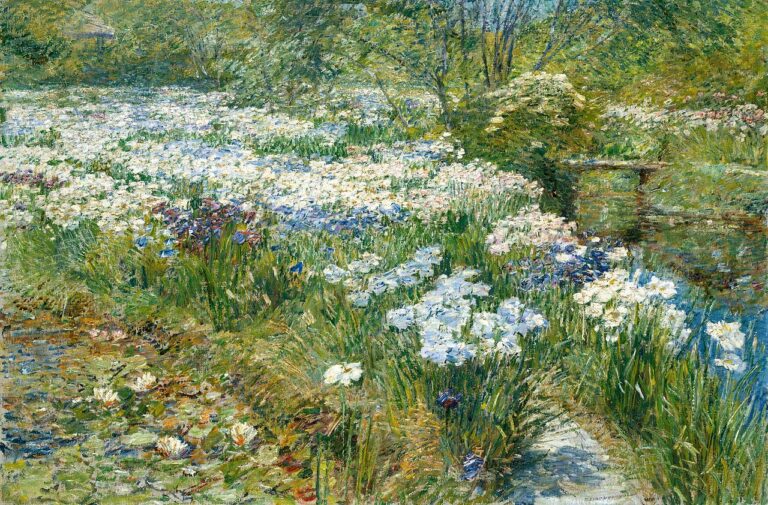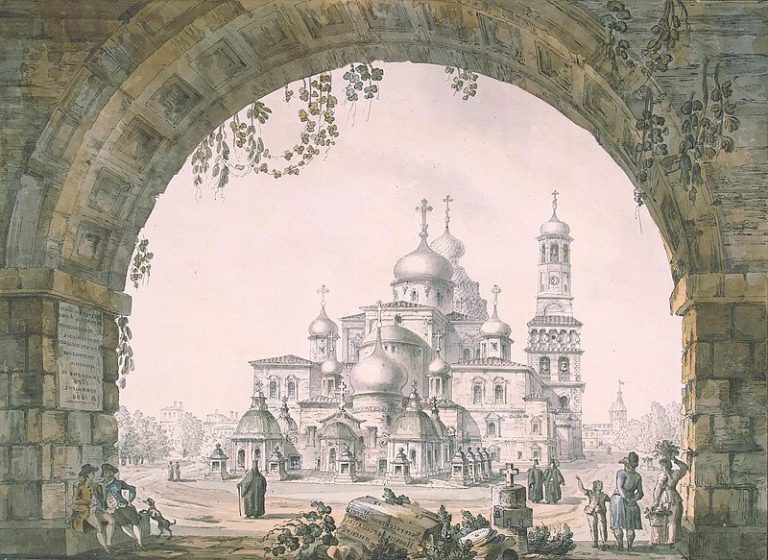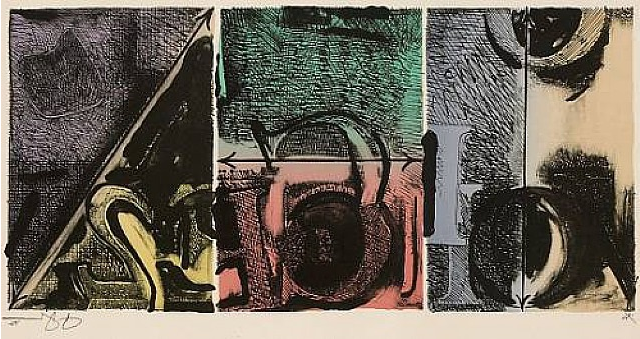Carl Larsson, Painter: The Swedish Master of Idyllic Domestic Scenes
Born: 28 May 1853, Stockholm, Sweden
Death: 22 January 1919, Falun, Sweden
Art Movement: Arts and Crafts, Art Nouveau
Nationality: Swedish
Institution: Royal Swedish Academy of Arts
Carl Larsson, Painter: The Swedish Master of Idyllic Domestic Scenes
Life and Career of Carl Larsson
Carl Larsson was born in 1853 in Stockholm, Sweden. His early life was marked by poverty, but his artistic talents were recognized when he was young.

Mamma’s and the Small Girls’ Room, 1897 by Carl Larsson
After showing promise as an artist, Larsson studied at the Royal Swedish Academy of Arts. During his time at the Academy, he earned his first medal for nude drawing and worked as a caricaturist for a humorous paper called Kasper.
Following his formal education, Larsson worked illustrating books, magazines, and newspapers to earn a living. This practical experience helped develop his distinctive style.
Paris became an important chapter in Larsson’s life as he spent several years there trying to establish himself as an artist. Later, he joined the Scandinavian artists’ colony in Grez-sur-Loing, France, where his artistic style evolved significantly.
It was in Grez-sur-Loing that Carl met his wife, Karin Bergöö, who was also an artist. Their marriage proved to be both personally and professionally significant for Larsson’s career.
Despite his cheerful paintings, Larsson struggled with depression at various points in his life. These personal struggles contrasted sharply with the idyllic family scenes he became famous for.
Many of Larsson’s most beloved paintings depict his home and family life. These works became models for a new Swedish ideal of domestic living.
Carl Larsson documented his life experiences in his memoirs, offering insights into his artistic development and personal philosophy. He died in 1919, leaving behind a remarkable artistic legacy that continues to be cherished today.
Artistic Style and Techniques
Carl Larsson developed a distinctive artistic style that combined traditional Swedish folk art with modern design elements. His techniques evolved throughout his career as he mastered various mediums and found his unique visual voice.
Watercolors and Oil Paintings
Larsson’s watercolor technique became his signature style, characterized by clean lines and bright colors that created a sense of light and warmth. He often painted on paper with thin, transparent washes that allowed the white of the paper to shine through. This technique gave his works a luminous quality.
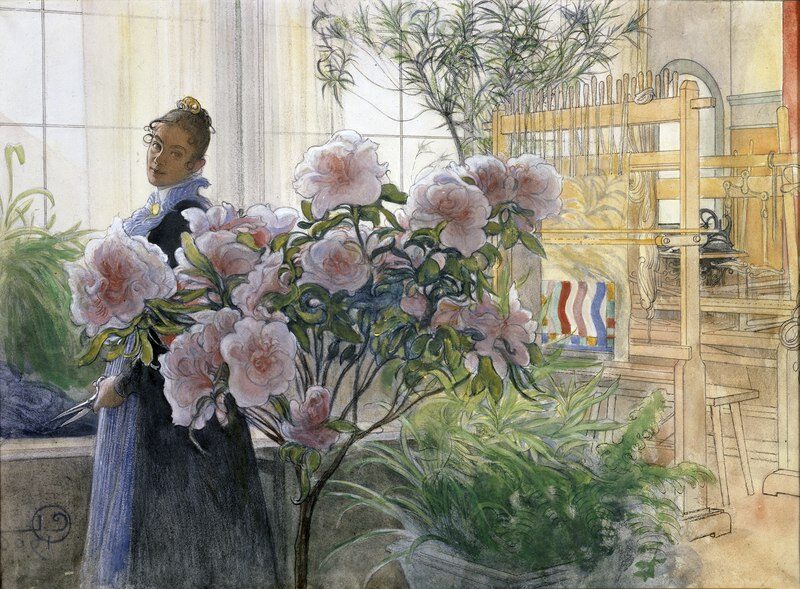
Azalea, 1906 by Carl Larsson
Unlike the Impressionists or Barbizon school, Larsson developed a more decorative approach. His paintings featured clear outlines and flat areas of color rather than blurred forms.
Early in his career, Larsson worked with oil paintings, particularly during his time as an open-air painter in France. He later moved away from oils, finding watercolors better suited to his artistic vision.
Some of his important works in these mediums include the series of paintings depicting his family home, which showcased his mastery of light and color.
Illustrations and Frescoes
As an illustrator, Larsson developed a bold, graphic style with strong outlines and simplified forms. His illustrations appeared in books and magazines, often featuring scenes from everyday life drawn with precision and charm.
Larsson’s illustration work influenced his painting style, bringing clarity and narrative quality to all his art. He used pen and ink with watercolor washes to create detailed yet accessible images.
His monumental fresco “Midwinter Sacrifice” for the National Museum in Stockholm demonstrated his ability to work on a grand scale. This controversial work showed his skill in historical composition and dramatic storytelling.
Larsson also created frescos for schools and public buildings, using techniques he learned during his studies at the Antique school. These works often featured Swedish historical themes executed with his characteristic clear lines and bright colors.
His style aligned with the Arts and Crafts movement’s emphasis on craftsmanship and decorative elements while maintaining a uniquely Swedish character.
Cultural Impact and Legacy
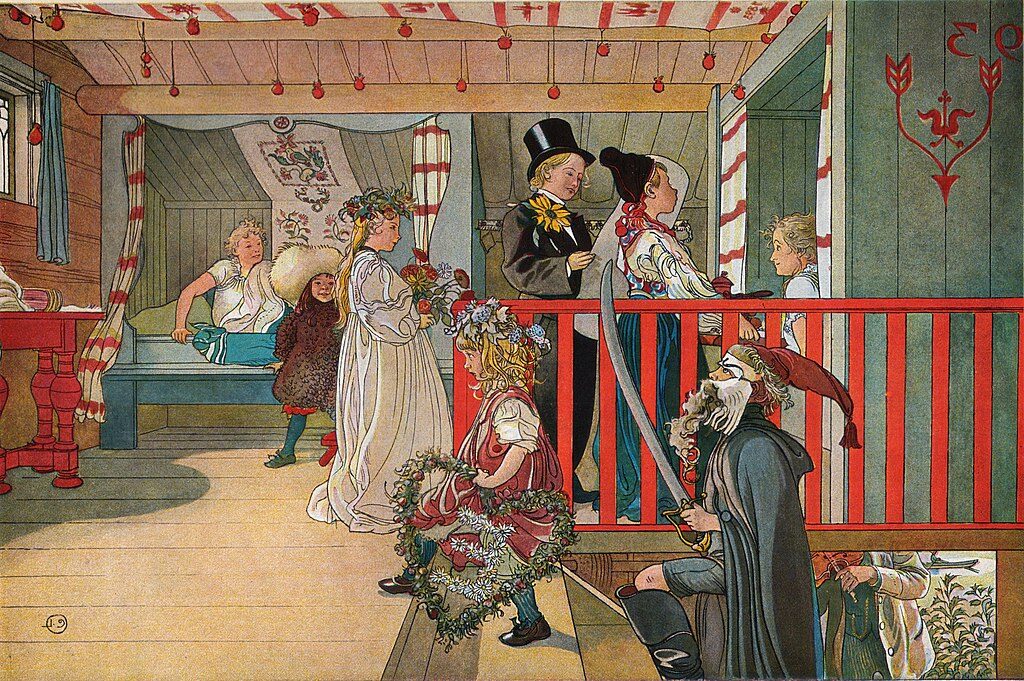
Nameday at the Storage House, 1897 by Carl Larsson
Carl Larsson’s influence extends far beyond his lifetime, shaping Swedish design aesthetics and promoting an idealized vision of domestic life. His artistic legacy continues through museum collections, publications, and his enduring impact on interior design.
Influence on Swedish Art and Architecture
Larsson’s paintings of his home in Sundborn created a distinctively Swedish style that influenced national design for generations. His bright colors, functional simplicity, and celebration of family life became hallmarks of Swedish interior design. The Larsson home, Little Hyttnäs, turned into a model for the “Swedish style” that valued light, practicality, and beauty in everyday objects.

Crayfishing, c. 1898 by Carl Larsson
Karin Larsson, his wife and an interior designer, collaborated with Carl to create spaces that rejected Victorian excess in favor of folk-inspired simplicity. Their light-filled interiors with painted furniture and colorful textiles still inspire modern Scandinavian design.
The “Larsson style” promoted idealized family life while celebrating Swedish traditions. This visual language helped shape Swedish national identity during a time of rapid industrialization.
Major Works and Exhibitions
Larsson’s most famous works include the watercolor series “A Home” (Ett hem), published in 1899, which showed intimate scenes of his family house in Sundborn. “The Kitchen,” “Family and Home,” and “A Studio Idyll” remain among his most recognized domestic scenes.

The Kitchen, c. 1898 by Carl Larsson
Beyond his idyllic family paintings, Larsson created monumental works like “Midvinterblot” (Midwinter Sacrifice) for the Swedish National Museum of Fine Arts (Nationalmuseum). Initially rejected, this large-scale painting was eventually installed in its intended location in 1997.
His works are prominently displayed in the Nationalmuseum in Stockholm and the Finnish National Gallery. Major exhibitions of Larsson’s art continue to draw crowds, including retrospectives featuring “Apple Blossom,” “Christmas Morning,” and his compelling self-portraits.
German publishing houses and Swedish publisher Bonnier helped spread Larsson’s work internationally through illustrated books. His paintings in Sundborn Church further demonstrate his versatility beyond domestic scenes.
Frequently Asked Questions
Carl Larsson’s life and work spark many interesting questions. These common inquiries help shed light on his artistic contributions, family life, and lasting cultural impact in Sweden and beyond.
What are the notable works of Carl Larsson?
Carl Larsson created hundreds of memorable paintings, but several stand out in his collection. His series of watercolors depicting his family home in Sundborn, published in books like “A Home” (Ett hem) and “The House in the Sun” (Solsidan), rank among his most beloved works.
“Breakfast in the Open” shows his family dining outdoors, capturing Swedish summer traditions. “The Bridge” presents his children playing on a small wooden bridge, demonstrating his skill in depicting childhood joy.
His large-scale murals in public buildings, including “Midvinterblot” (Midwinter Sacrifice) at the National Museum in Stockholm, showcase his talent for monumental works beyond domestic scenes.
Can you visit Carl Larsson’s house-museum in Sundborn?
Yes, Carl Larsson’s home in Sundborn, Sweden is preserved as a museum called “Carl Larsson-gården” (The Carl Larsson Farm). The house remains largely as it appeared in his famous paintings.
Visitors can tour the colorful interiors that inspired his most famous works. The home showcases the distinctive decorative style created by Carl and his wife Karin, featuring bright colors, Swedish folk designs, and innovative furniture.
The museum is open to the public most of the year, with guided tours available. Many art enthusiasts make pilgrimages to this site to experience firsthand the spaces that inspired Larsson’s iconic domestic scenes.
How has Carl Larsson influenced Swedish art and culture?
Carl Larsson’s influence on Swedish culture extends far beyond fine art. His vision of home life helped shape Swedish interior design aesthetics that continue today.
His paintings established an ideal of Swedish domestic life that influenced generations of homemakers. The bright, functional, and child-friendly interiors he depicted became a model for Swedish design principles.
Swedish furniture company IKEA draws inspiration from the Larsson aesthetic, bringing elements of his style to homes worldwide. His work helped establish Sweden’s reputation for combining beauty with practicality in design.
What is the artistic style associated with Carl Larsson’s paintings?
Larsson developed a distinctive style blending several artistic influences. His work features elements of Arts and Crafts movement principles with traditional Swedish folk art motifs.
His watercolor technique is immediately recognizable, using clean lines and bright, flat areas of color. This approach was influenced by his background in illustration and Japanese woodblock prints that were popular in Europe at the time.
Larsson’s style balances detailed observation with decorative elements. His paintings often combine realistic portraiture with stylized patterns and design elements, creating a harmonious blend of realism and decoration.
How did Carl Larsson contribute to the National Romantic movement?
Larsson played a significant role in Sweden’s National Romantic movement around the turn of the 20th century. His work celebrated Swedish cultural identity through depictions of traditional rural life and customs.
He incorporated Swedish folk art motifs and traditional craft techniques in his home decoration, helping to revive interest in these cultural elements. His paintings of seasonal celebrations and everyday family activities highlighted distinctly Swedish traditions.
His public murals often featured themes from Swedish history and folklore, reinforcing national identity during a period when many countries sought to define their cultural uniqueness.
What was the role of Carl Larsson’s family life in his artwork?
Family formed the central subject of Larsson’s most beloved paintings. His wife Karin and their eight children appear in countless works, serving as both subjects and inspiration.
The Larsson family home in Sundborn became his primary studio and inspiration. The rooms, gardens, and everyday activities of family life provided endless material for his art.
His paintings show genuine affection for family life, capturing both special occasions and ordinary moments. These intimate family scenes resonated with viewers who saw in them an ideal of domestic harmony that many aspired to create in their own homes.

